Everton Women hosted Manchester United Women in the FAWSL 2019/20 fixture which served as the game to inaugurate their newly built Walton Hall Park stadium. The match also recorded Everton Women’s highest attendance till date and it was an exciting match-up with the pressure on both sides separated only by a point in the league table.
The game finished 2-3 suggesting it was a very close fixture on a windy afternoon. Manchester United Women finished the first half leading 2-0 spearheaded by a Leah Galton double. Toone managed to extend the lead in the beginning of the second half as the hosts came out aggressively looking to catch up, but the toffees managed to inch closer to a draw in the final quarter hour. A tactical analysis will help us break down the game and understand the tactics of both teams through the game using statistics and visual analysis of different moments of the game.
Lineups
Everton Women, managed by Willie Kirk have shown a positive mentality in their football despite lacking the quality of players that bigger teams possess. They rely on aggressive pressing and direct football to punish opposition errors. In this fixture, they lined up in a 4-2-3-1 throughout the game.
Everton Women (4-2-3-1): MacIver, Morgan, van Es, Finnigan, Turner, Clemaron, Stringer, Boye-Hlorkah, Graham, Kaagman, Kelly
Substitutes: Levell, Hinds, Magill, Pike, Cain, Korpela, Coan
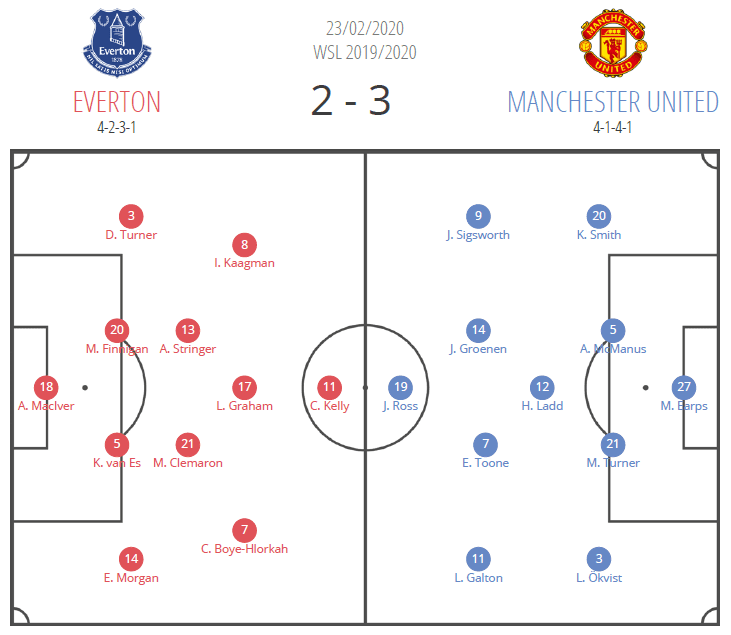
Manchester United Women, led by Casey Stoney looked to challenge Kirk’s side with a 4-1-4-1 formation with a single deep-lying pivot and two attacking midfielders. They did not seek a lot of possession in the midfield and preferred sending the ball out into the wide areas where they could exploit the pace of their wingers.
Manchester United Women (4-1-4-1): Earps, Smith, McManus, Turner, Okvist, Sigsworth, Ladd, Toone, Galton, Groenen, Ross
Substitutes: Harris, Turner, Palmer, Zelem, Mikalsen, Arnot
xG comparison
If we evaluate the xG of both teams on the game timeline, we see that the hosts had a higher xG of 1.35 in comparison with the visitors who had an xG of 1.09. Everton also had a much better xG in each individual half. Why were they trailing then?
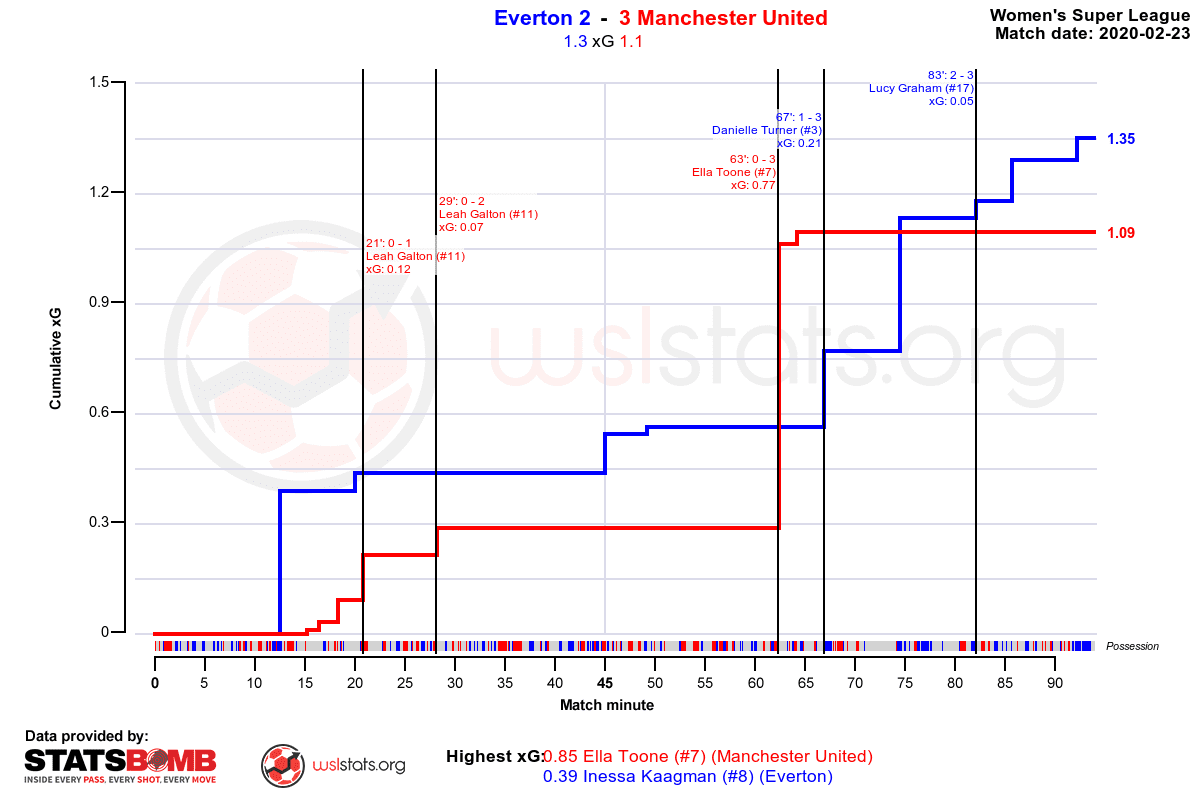
If we analyse the game closely, we see that the goals were scored in situations of a lower xG compared to the opposition (except for the last goal, which was an anomaly). This game favoured the team with the better pressing strategy, rather than the one with better possession. We shall evaluate the pressing organisations of both teams in detail further.
Both teams had an even share of possession with Everton Women having 48% and Manchester United Women having 52% of possession. Both teams also made the most of their possession opportunities scoring at the peak of their possession sequences as we can see in the visual graph below. Manchester United Women had a slightly better possession sequence (48% compared to Everton’s 40%) that reached the opposition half because they were more efficient with their dribbling into the final third through players like Galton and Ross.
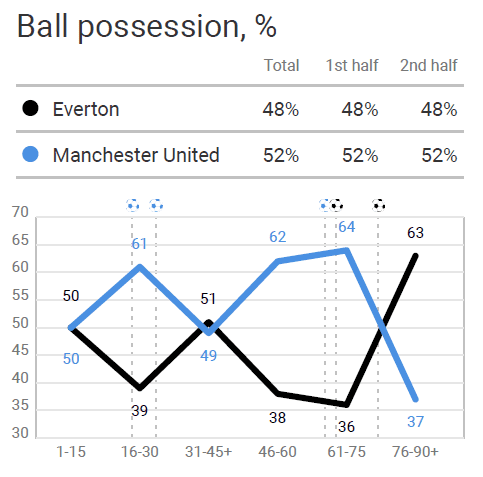
Manchester United Women’s attacking strategy
As mentioned earlier, Manchester United looked to spend less time keeping possession in the middle and immediately attack the wide wings upon winning possession. The 4-1-4-1 is a formation that always naturally counters the 4-2-3-1, especially in the midfield as each player gets marked out in numerical equality. Then, it all comes downs to domination of the wide areas, and which team is more aggressive in pressing forward. This is exactly what happened in this game between both teams. It was the more aggressive full-backs who offered dominance to their team. In the first half, it was clearly Manchester United, but Everton responded strongly being braver with their own full-backs.
If we look at Manchester United’s attacking organisation in this graphic below, we see how Everton’s double pivot of Stringer and Clemaron gets pressed by Toone and Groenen providing no free man in the midfield to play out. Ladd would stay deeper for United making sure Graham doesn’t get too much space to receive the ball and play the dangerous passes. In the wide areas, Okvist and Smith pushed up aggressively forcing Boye-Hlorkah and Kaagman to stay deep while Galton and Sigsworth were always ready to attack the spaces behind the defensive line in the final third. United had more passes into the final third (28 out of 48 or 48%) comparing to Everton (13 out of 51 or 25%).
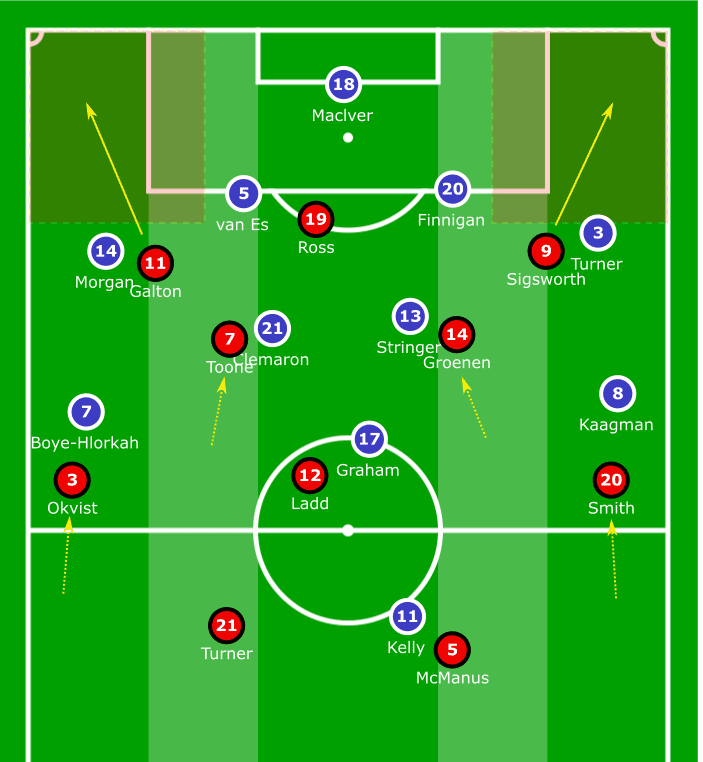
In another instance, we see how United set up traps for Everton’s full-backs and used the positioning of their wingers to counter. In this Everton goal-kick scenario, we see van Es and Finnigan inside the box with Maclver for the short kick. Stringer and Clemaron are cut out by Toone and Groenen again with an effective man-oriented press. This leaves Finnigan with only one option to play it wide to Turner (not shown in the frame). Sigsworth is positioned not too close to Finnigan but not marking Turner either. She leaves Smith the right back behind her to press Turner so that she can attack the space behind Turner from Everton’s loss of possession.
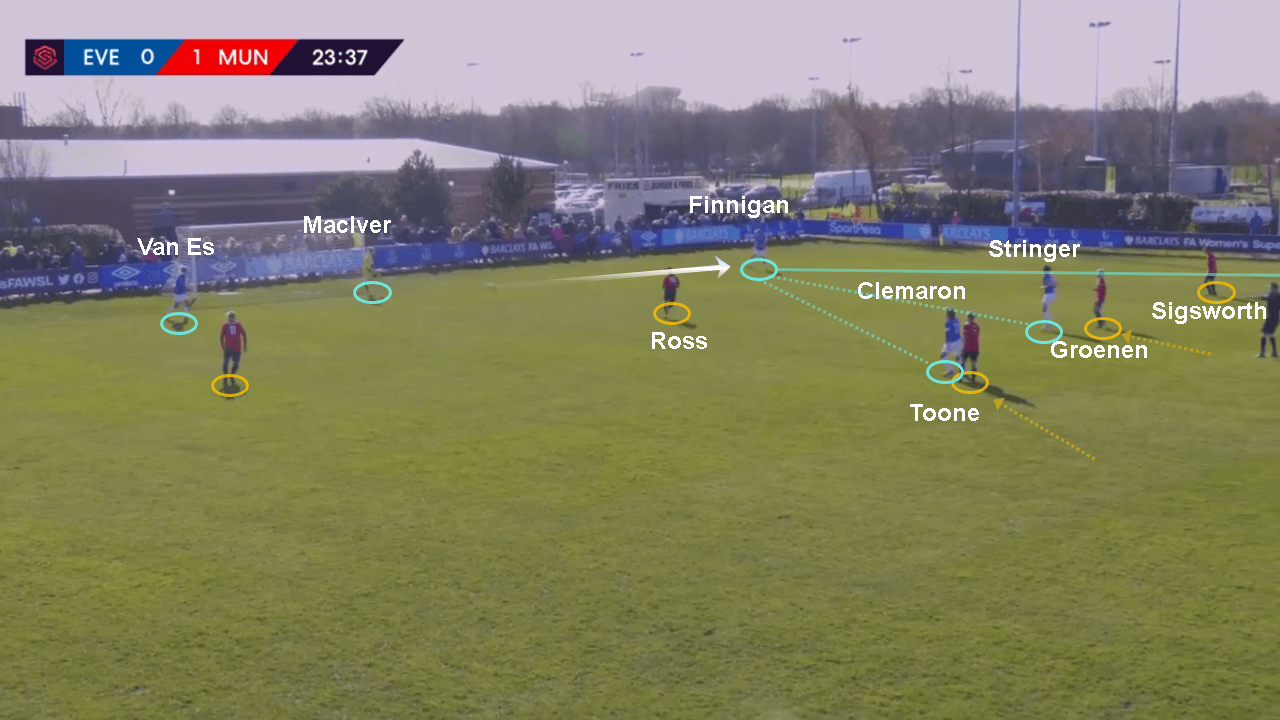
We see a similar situation on the other side which United exploited successfully. Okvist compromises the space behind her with Boye-Hlorkah unmarked in favour of pressing Morgan who will receive the pass from her centre half. Ross, Toone and Groenen close all the spaces in the middle, while Galton is positioned strategically to pounce on a loss of possession and counter.
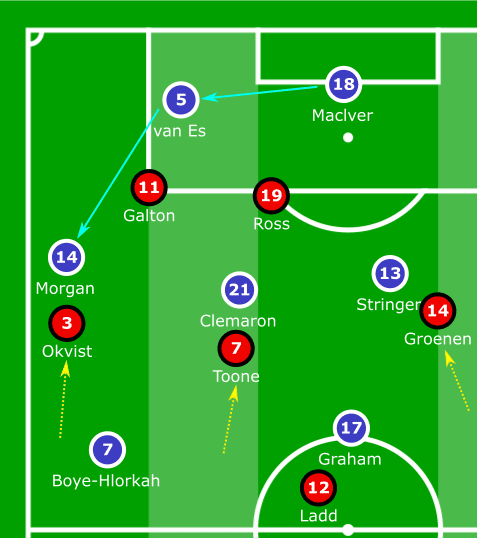
This tactic did leave risk behind the full-backs who pushed up, and in multiple instances, Everton found opportunities to attack the spaces behind. Boye-Hlorkah was able to dribble past Okvist and play successful crosses into the box, but Kelly was unable to convert it. Kaagman also had the highest xG of 0.44 from Everton during the game. Here we see the crosses that United conceded and Boye-Hlorkah stood out with her dangerous crosses from the right wing.
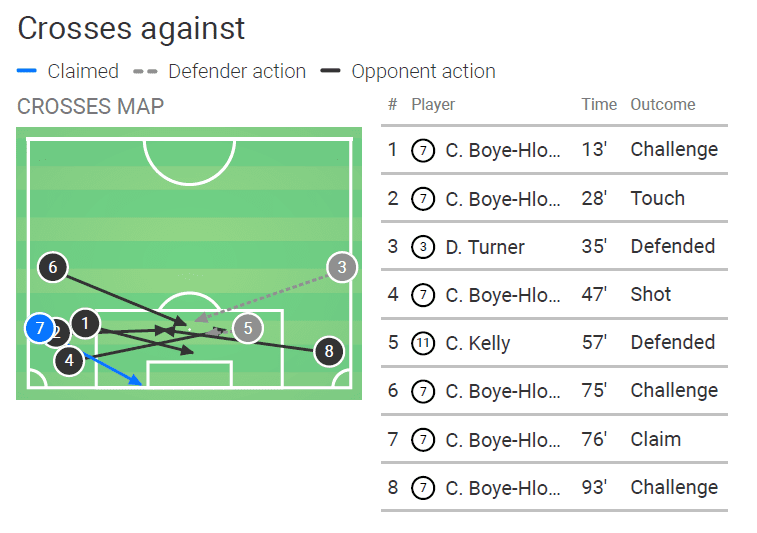
Everton’s weakness on the right
Galton playing as the left winger for United managed to punish Everton successively on two occasions that put the visitors in a hugely advantageous position. After the two goals it became clear that Everton looked handicapped on the right side and United repeatedly looked to exploit this weakness.
Kirk decided to play the 19-year-old recent loanee from Manchester City, Esme Morgan, as the right back. Although at 1.77m she was able to match a 1.70m Galton in physical height, she struggled positionally from the beginning. Morgan was caught too central and close to van Es at times leaving a lot of room for Galton to receive the ball in space and dribble.
In this graphic, we see a situation where Ross, the United centre-forward, receives the ball and van Es immediately presses her from the front, while Stringer presses from behind. Morgan joins the press ending up too close to van Es, thereby leaving a lot of room for Galton on the wide area to either look for a long ball to switch play to the other side or dribble herself.
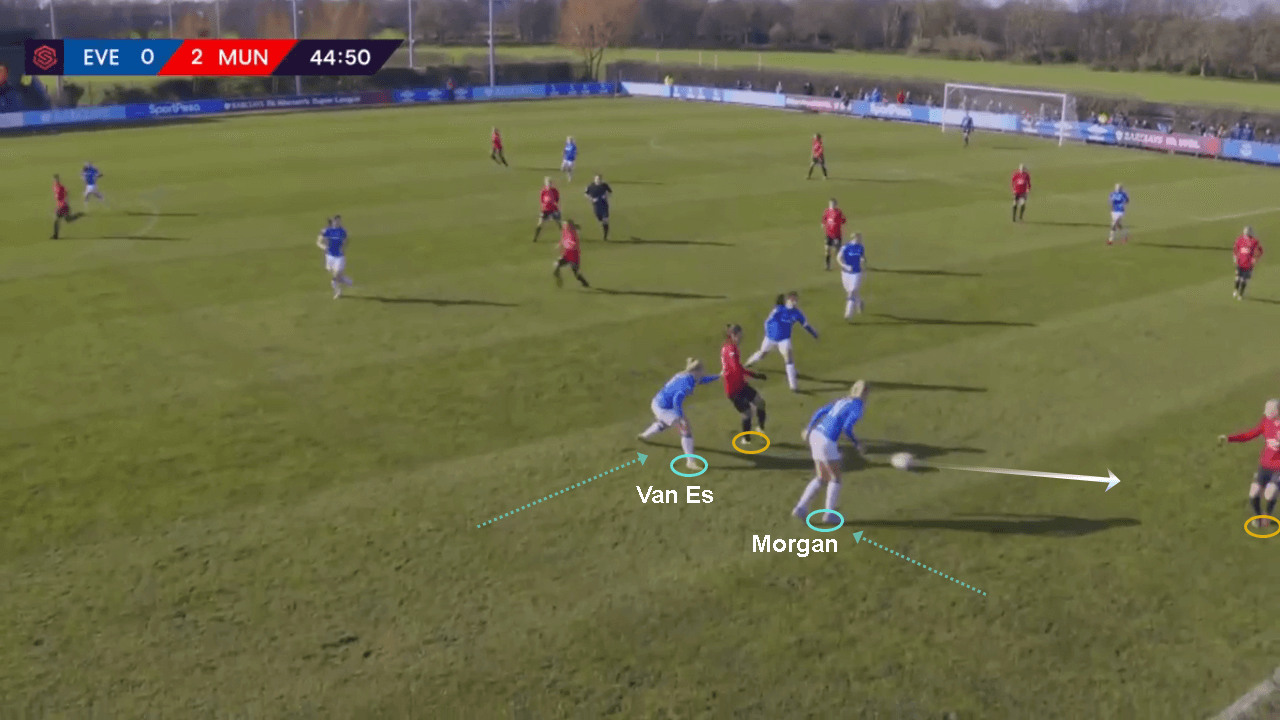
In another situation, we see Everton slightly deeper in defensive transition. Morgan erroneously decides to press instead of holding the defensive line with the others and covering Galton on the wide flank. She didn’t need to push forward as Stringer was already in place to apply pressure. This makes a free passing lane to Galton who finds herself in a lot of space to dribble and beat Morgan in a 1v1 scenario with her technical ability.
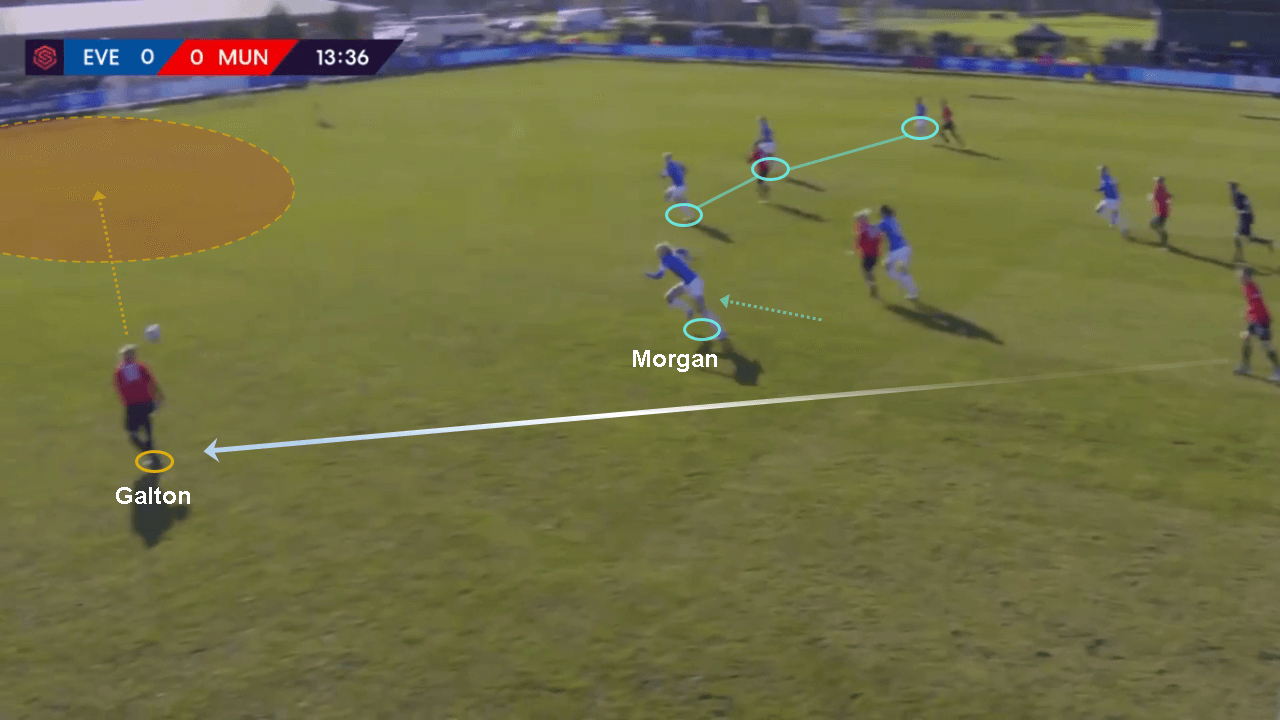
Morgan’s rookie defending errors ending up costing Everton in the first half-hour with goals from Galton in very similar fashion. In the second half, Everton pressed higher with their full-backs more positively and we saw Morgan move wider and overlap Boye-Hlorkah. She was much more effective as an attacking threat. If we compare United’s dribbles in both halves, we see them being much more successful in the first half with Galton finding lots of space on the left to combine with her fellow players. In the second half, United sat back to defend and Everton pushed up much better, reducing the threat from the right side.
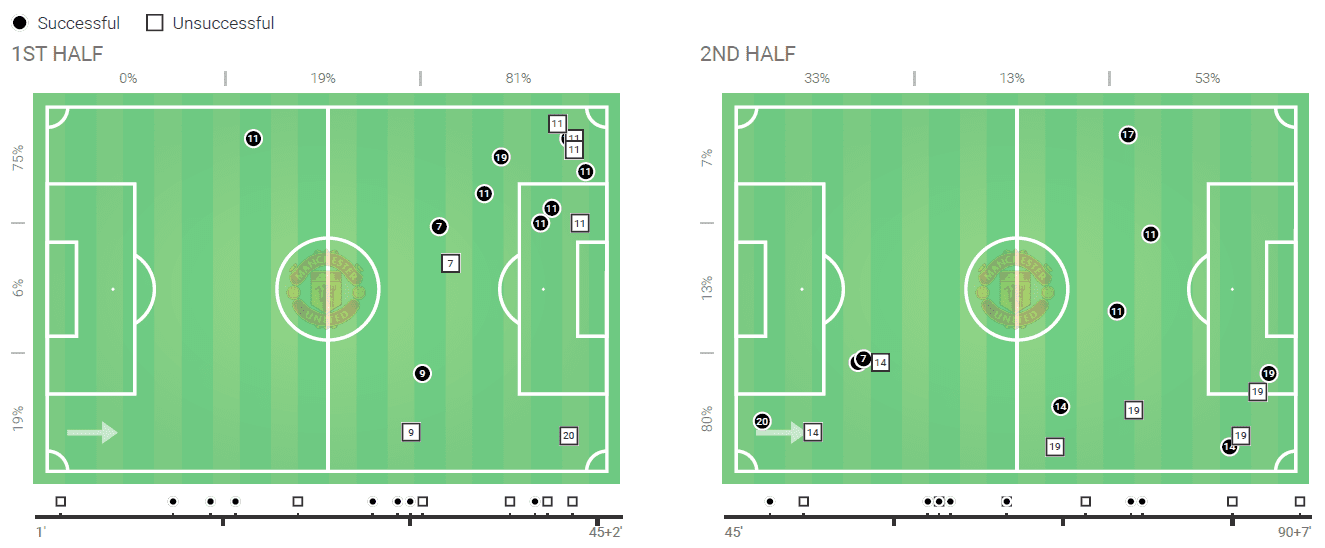
How did Everton’s pressing improve in the second half?
Kirk’s side, having a challenging task of chasing a two-goal deficit, came out much more positive in the second half. The defence began to play a much higher line, a couple of yards from the centre circle. The full-backs also pushed up bravely offering width. Stringer, who had a rather silent first half was far more involved alongside Clemaron in the middle. The wide wingers, Boye-Hlorkah and Kaagman began to tuck in more compact almost operating in the half-spaces behind Kelly and Graham as a free-roaming number 10 rather than the wide corridors. The 4-2-3-1 was a more high-pressing compact formation that immediately saw United suffocating in possession in their own half.
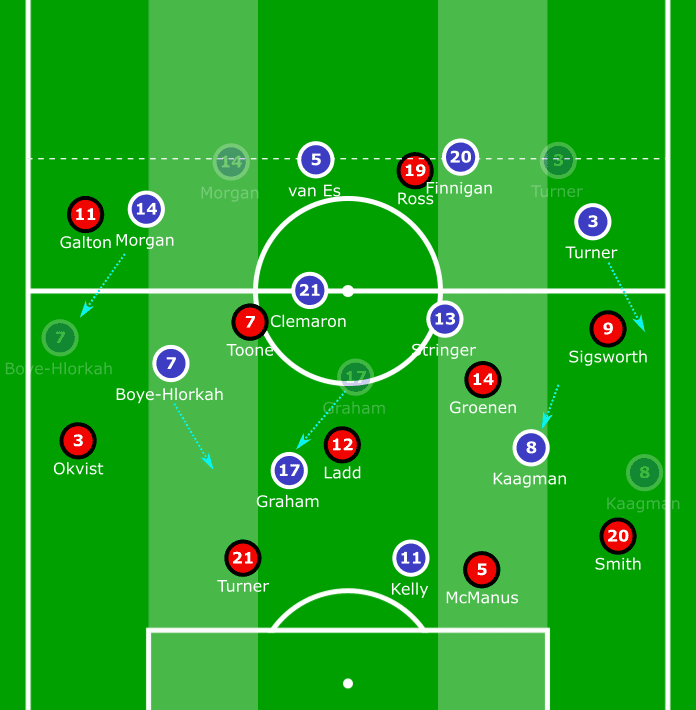
As we see below, the press was especially efficient on the left with Graham and Kaagman double teaming the full-back with possession of the ball behind Kelly who pressed the centre-back. The high line closed the space for the United forwards Ross and Groenen to receive the pass and when Turner pushed up against the winger Sigsworth, to whom Ross would look to lay off the ball wide, it became very difficult for even players of the calibre that United possessed to maintain possession.
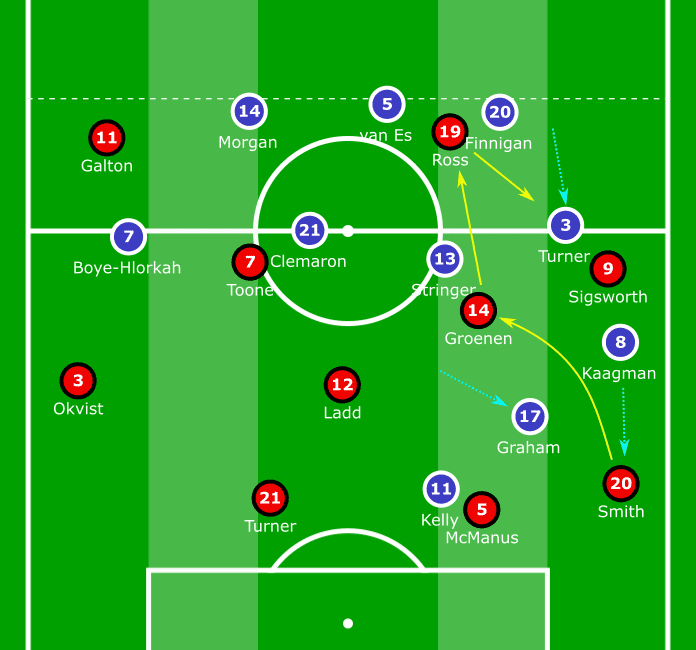
Here we see an instance from the game in the early minutes of the second half when United look to build up from the right side. Notice how high up the full-back Turner is pushing to apply pressure along with the midfielder, Stringer and the winger Kaagman who has tucked inside closer to Kelly. The effect of a narrow 4-2-3-1 saw Kaagman and Boye-Hlorkah much more involved in defensive actions for Everton.
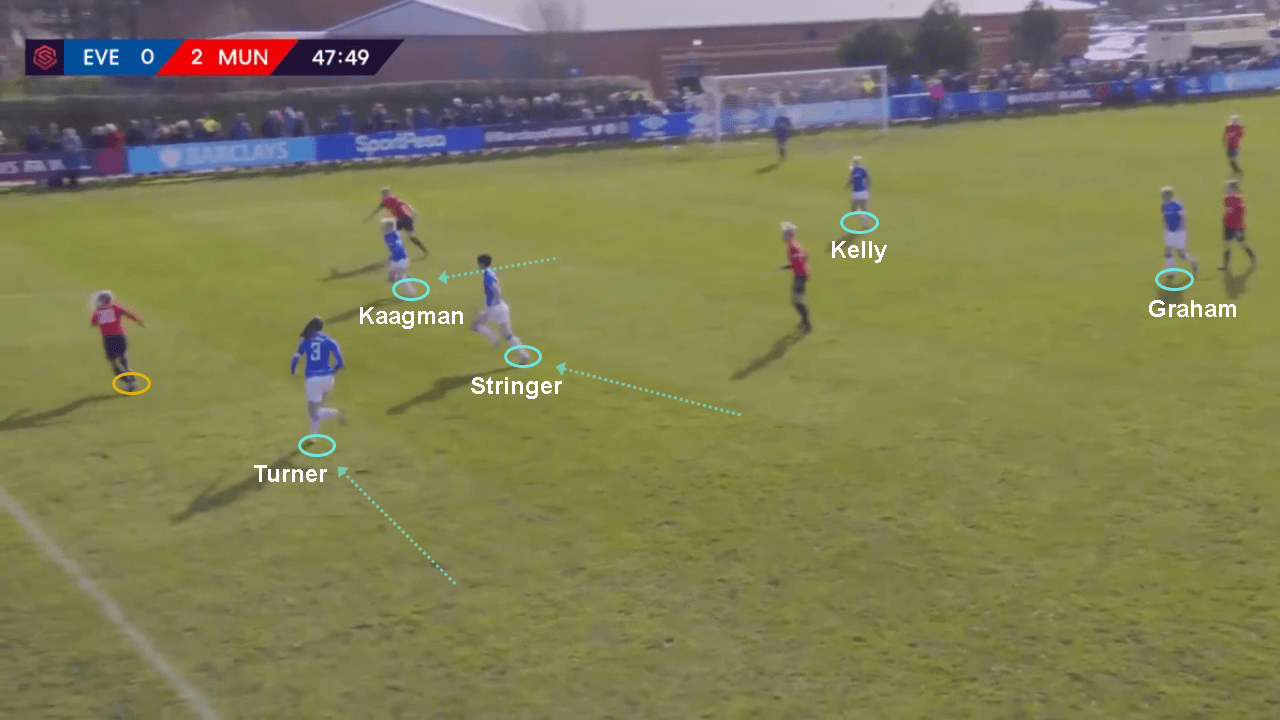
The high press tactic came with its own risks as Everton were the first to concede from a counter attack in the second half giving United a 3-goal lead. The high line was vulnerable to a loss of possession and as we see below here, United managed to exploit a counter attacking opportunity to punish Everton with Toone scoring for the visitors. Perhaps this explains why Kirk chose to start the game with a more conservative approach.
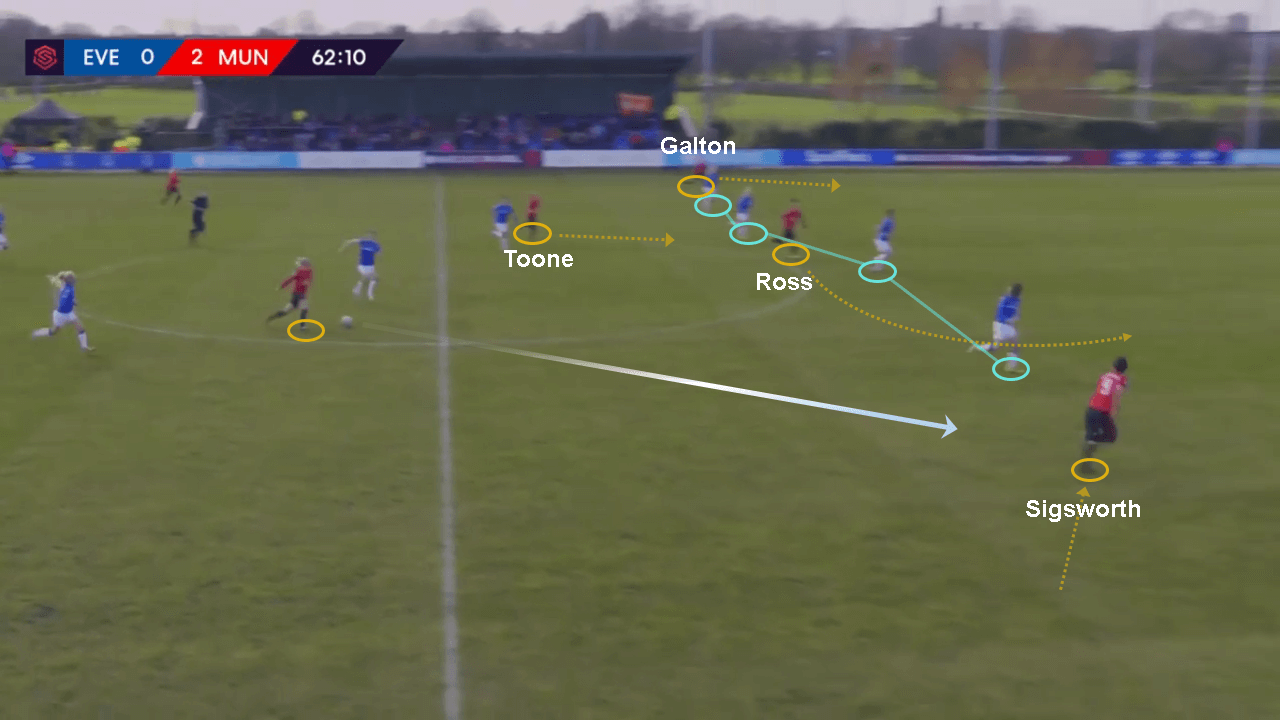
If we see in a shot from the first half here, where United’s centre-half, Turner makes a defensive error and concedes possession almost risking a 4v2 scenario, we observe that there were plenty of opportunities for Everton to dominate with their aggressive pressing strategy right from the beginning. This was especially because United looked uncomfortable when they had to sit back and defend and rather decided to take risks and push Everton back. As we see here before the loss of possession, the defenders are positioned wide and high with the aim of keeping possession and forcing Everton on the back foot. Everton had more key passes (eight) than United (three) during the game.
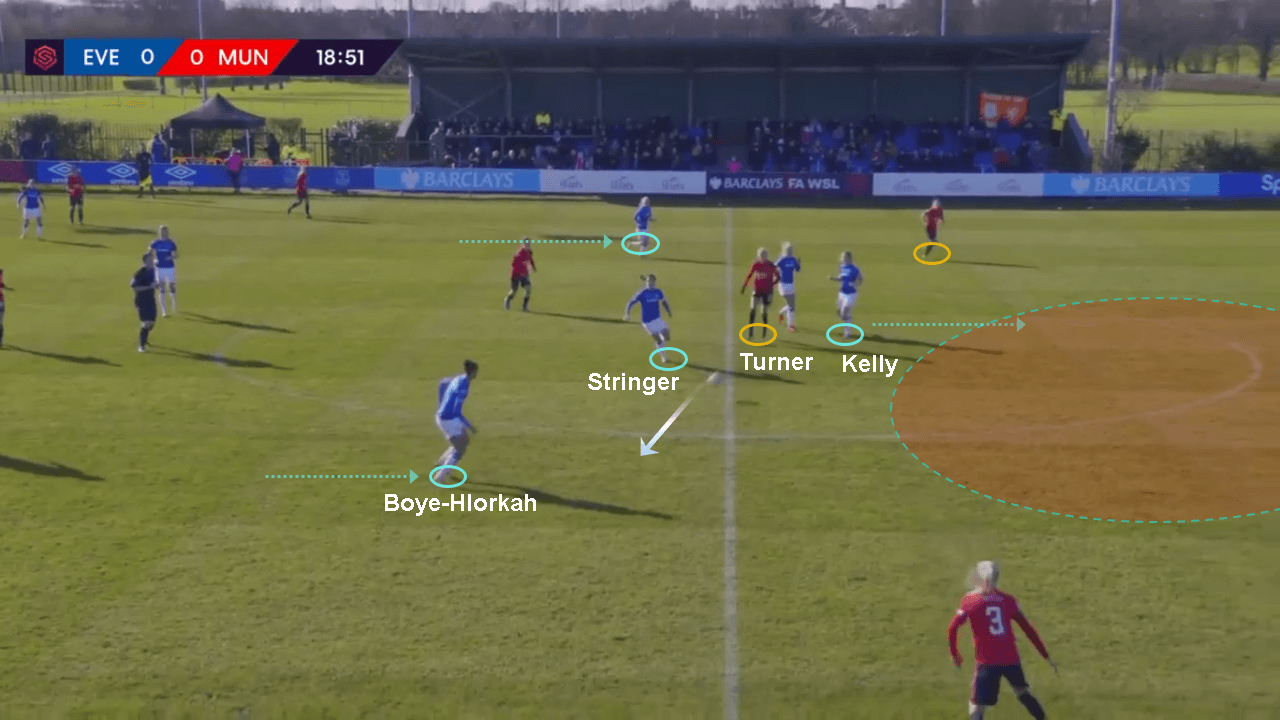
In fact, an analysis of the PPDA (passes per defensive action) of both teams during the game on a graph reveals that Everton, although chose to start the game conservatively, pushed up the intensity of their pressing after conceding two goals to United and maintained their press rather consistently for the remainder of the game. United, on the other hand, showed a progressive decline in their pressing intensity until they conceded goals to Everton in the second half. Overall Everton had a far better PPDA figure of 4.2 in comparison to United with 6.8 showing that the hosts were much more efficient with their pressing strategy.
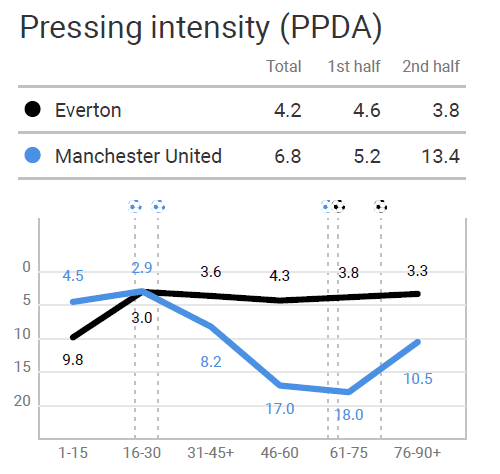
Everton’s dominance of the second balls
Another very important change in Everton’s behaviour which had a significant impact on their game in the second half was the intensity at which they looked to win the second balls. With the full-backs pushing high up and the defensive line cutting the field more compact with their high line, they were much more aggressive in pursuing the loose balls when United gave away possession under their high press. During the game, Everton won 14 of 31 loose ball duels (45%) in comparison to United who won 10 out of 31 duels (32%). As a result, they also had a bigger share of total duels won.
If we see a map of their recoveries in the first and second half, we clearly see them winning more aerial duels higher up the pitch in United’s half in the second period. We also observe that the pressing was a lot more efficient on the left side of the pitch, particularly due to the work of the full-back Turner who put a lot of pressure on United’s wide corridor and worked tirelessly despite the imbalanced scoreline. In the second half, we also see the midfielder Stringer (#13) far more involved in key recoveries in crucial positions behind the attacking players than she was in the first half.
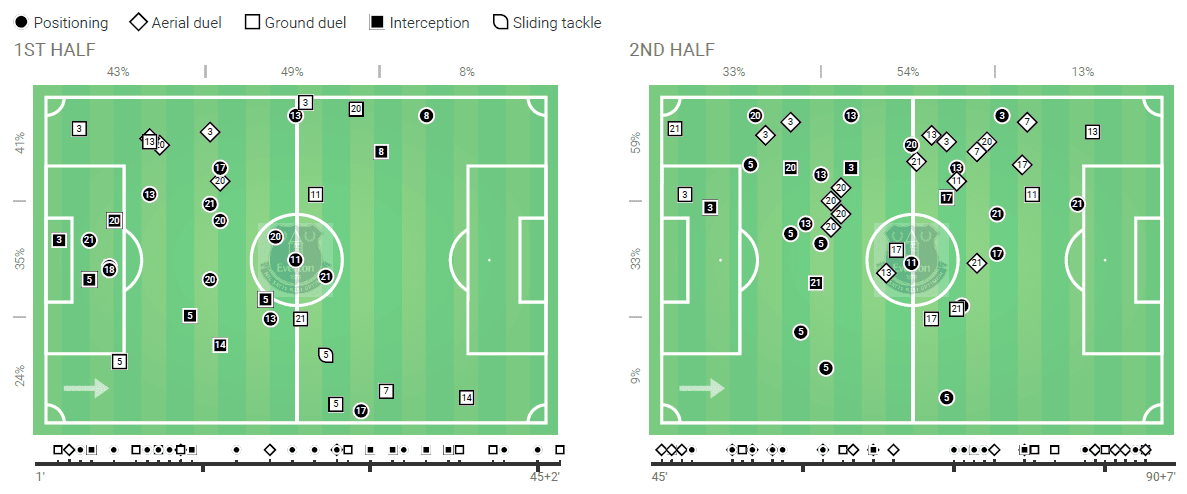
The goals that Everton scored were not a direct result of their pressing and dominance of duels in the second half. In fact, the first goal came as a result of a corner. United chose to defend Everton’s corner in a man-oriented marking, and it was Turner who beat her marker, Smith to the far post in a classic pick-and-roll manoeuvre with her teammate Morgan in front of her. Smith was blocked trying to track Turner and the ball floated just above Earps’ fingers for Turner to head it home neatly at the far post.
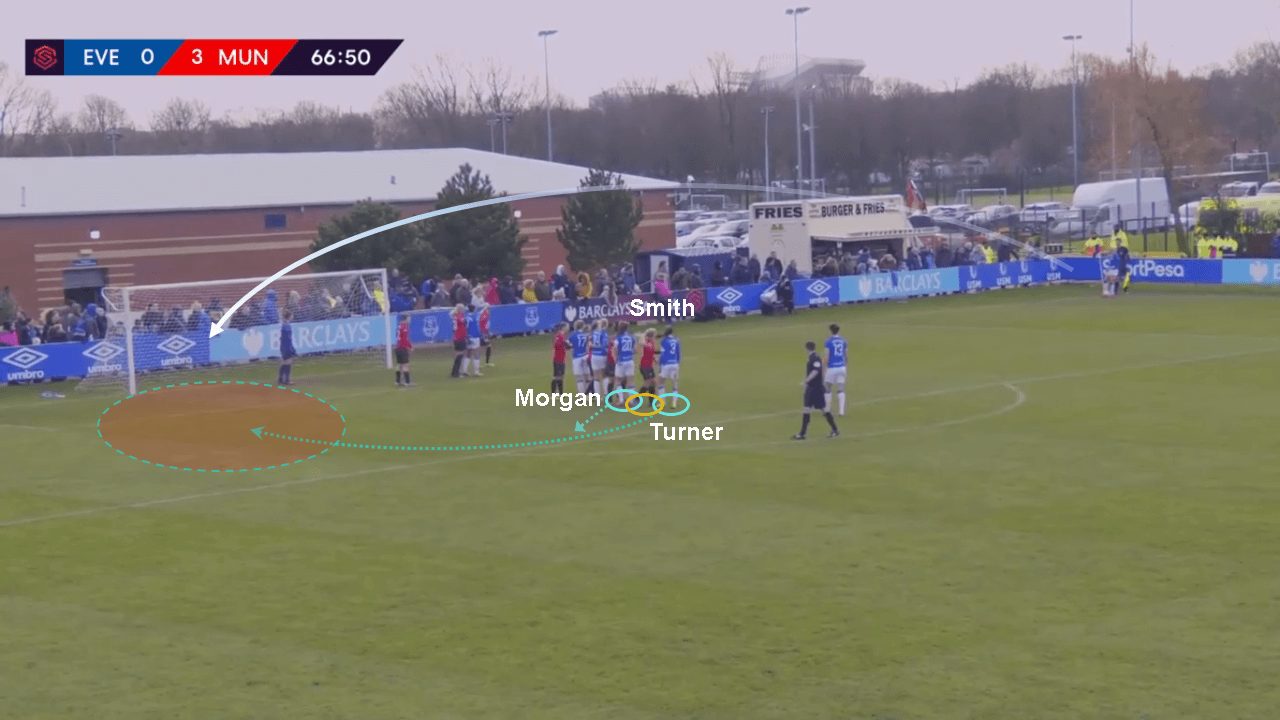
The second goal was a bit of fortune as what was intended to be a cross from out wide by Graham, managed to beat Earps due to the wind that favoured the home side in the second half. Hence we claimed it an anomaly to the pattern of the xG plot that we remarked in the beginning. Although the goals were not a direct consequence of the pressure that Everton applied, they did play a major role indirectly. Everton’s high pressure saw them win seven corners against one of United.
Conclusion
The win and three points see the gap between United and Everton extend to four points with the Manchester side sitting in fourth place on the table while the toffees are in seventh place. United showed how threatening they can be with the quality of players like Galton, Groenen and Ross. Stoney’s strategy to push the home side on the back foot early on paid off well, despite the consistency suffering in the second half.
Everton are a remarkable side especially with their work ethic and the intensity at which they can press. Kirk’s side could well be one of the best teams at pressing in the league because of their mentality. They showed great character even until in the final minutes of the game despite being 0-3 down to come back 2-3 to finish the game. The left-back, Turner put forth an outstanding performance with a big impact in the second half and a goal for the hosts. Everton are clearly more threatening when they play offensively than defensively, and utilise their forward players like Kelly, Graham, Kaagman and Boye-Hlorkah effectively.





Comments